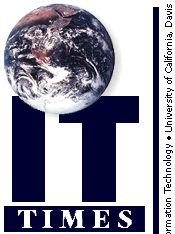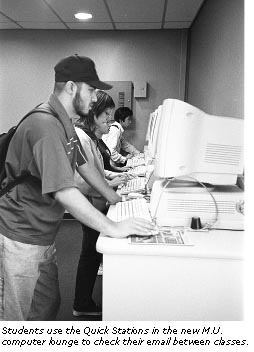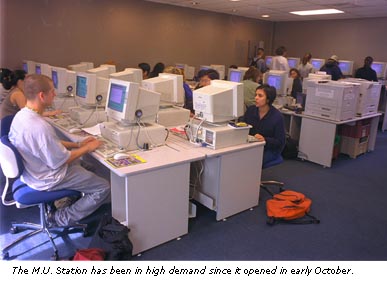
The M.U. Station: It's a Lounge, not a Lab
by Aviva LuriaSecond-year student Tiffany Hughes is pleased about the recent opening of The Station, the new computer lounge located in the Memorial Union's former East Conference Room. One of The Station's virtues, she says, is the absence of classes competing for computer time.
"You know you won't be interrupted," she says, looking up from the food chemistry lab report she's composing using Excel. "When you are in other computer rooms that are being used for classes, you're in the middle of something and then you have to save your work, leave, and go find another computer room."
 Hughes is one of roughly 30 students logged in to The Station's Macintoshes and PCs on this Friday afternoon. The Station is, even at first glance, different from other campus computer rooms. Perched on ledges on the east and west walls are 10 computers that students can stand at to check email or print. These "Quick Stations" have a suggested time limit of 15 minutes. And by the east entrance, two collaborative stations offer additional chairs and space where groups of students can work together.
Hughes is one of roughly 30 students logged in to The Station's Macintoshes and PCs on this Friday afternoon. The Station is, even at first glance, different from other campus computer rooms. Perched on ledges on the east and west walls are 10 computers that students can stand at to check email or print. These "Quick Stations" have a suggested time limit of 15 minutes. And by the east entrance, two collaborative stations offer additional chairs and space where groups of students can work together.
"A good deal of thought went into the design of The Station. We wanted to meet different needs," says Peter Blando, Information Resources Lab Management operations manager. Collaborative stations, for instance, are new to the UC Davis campus. "Some academic work requires student collaboration and access to computers, whether it's to write a paper or complete labwork. Other universities have similar stations -- we're trying to meet the needs of students."
Second-year engineering student Bobby Roy is enthusiastic about the lounge. Although he owns a computer, Roy finds it convenient to drop by the Station when on campus. "They have everything here that you could ever ask for," he says. And like most busy students, he appreciates the quick turn-around. "My day ends at about 2 p.m., so I come here after that. Usually there are a lot of people here, but people leave really quickly," he says.
The turn-around can be explained by statistics gathered by Lab Management: At The Station, an average of 69% of PC sessions and 61% of Mac sessions are less than 15 minutes long. "A good portion of that is the Quick Access stations, which students use to check their email or print," says Blando. "That's the pattern in all the labs, whenever they're open access -- nearly 60% use the computers for 30 minutes or less."

The Station, however, is not like an ordinary computer room; it's a computer lounge. "It doesn't feel like a lab," says Scott Reed, president of ASUCD, which pushed for and helped fund and sponsor The Station in collaboration with Student Affairs and Information Technology's Information Resources. "A lab is concentrated primarily on schoolwork and the lounge has the capabilities for schoolwork, but you can also check your email, have fun in a lounge."
Despite the potential for fun, the motivation behind the inception of The Station stemmed from a serious need. Before The Station opened at the start of this quarter, campus computer rooms housed a total of 197 machines, amounting to a ratio of students to computers of 175.6:1. The Station's 19 Dell PCs and 15 PowerMac G3s, together with upgrades in some other campus classrooms, have brought the total number of available workstations to 335, and reduced the students-to-computers ratio to 154.2:1.
Student surveys conducted by Information Resources Lab Management in the winter quarters of 1997 and 1998 revealed that opening an open-access computer room, in addition to the one at TB 114, was the "most important way to improve overall computer access" (see graph). Surveyed students also voted for more computers and more open use time as improvements they'd most like to see in computer classrooms, and overwhelmingly supported the core campus as the prime location for a new room. According to Reed, ASUCD representatives hear from their peers that increased access to computers is a top priority. "Students don't have the time to wait for hours to get on a computer," says Reed. The classes that share time at most of the other computer rooms on campus make it difficult for students to get their work done, he says. "This lab is for students. We've put it in a location that's accessible for them. We want them to be able to use it."

Student Affairs, MU Auxiliary Services, CURB (Campus Unions and Recreation Board), and Information Technology were in agreement about the need for increased student access to computers. The Station is the product of their ongoing collaborative efforts to find and secure space and funding for more campus computer rooms.
| Percentage of Undergraduate Students with Campus Computer Accounts (as of 11/2/98) | |
|---|---|
| Class Level | % of Total |
| Freshman | |
| Sophomore | |
| Junior | |
| Senior | |
According to Reed, ASUCD jumped at what was a rare opportunity "to get this kind of real estate and this kind of commitment from other entities on campus. In under a year we've already had a product out. On a university campus that is amazing." The M.U. dedicated space by moving a conference room and jointly funding, with ASUCD, improvements to the space. IT provided the equipment, set up, and ongoing maintenance and support.
"This is part of an ongoing effort," says Blando. "There are plans for more computer rooms." The Visualization Lab recently moved into temporary classrooms west of Academic Surge, freeing up 301B Surge IV for a future classroom or general access lab. And two small rooms in Olson basement will be combined to create another large classroom. The popularity of The Station shows the project to be a success: Statistics compiled by Lab Management indicate that since mid-October, The Station has often reached capacity or near-capacity on weekdays between 9 a.m. and 6 p.m. Usage of the other open-access room, TB 114, which has been open since Fall 1997, hits maximum or near-maximum on weekdays between 9 a.m. and 5 p.m.
"The Station by itself cannot solve all our access problems, but it certainly is making a big difference for many students," says Blando. "It shows that when we all work together for a common goal, we really can get things done."
Resources
Lab Management's Web site (http://lm.ucdavis.edu/) includes results and analyses of student surveys referenced in this article and information on campus computer rooms' equipment, hours, and availability.